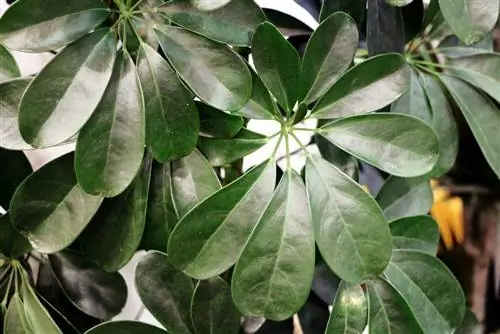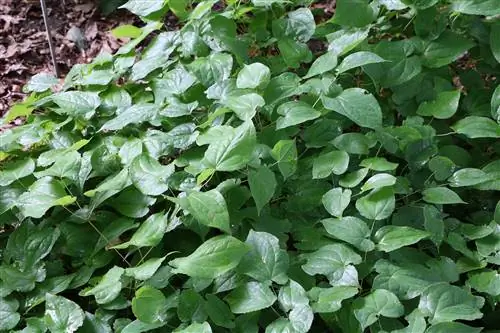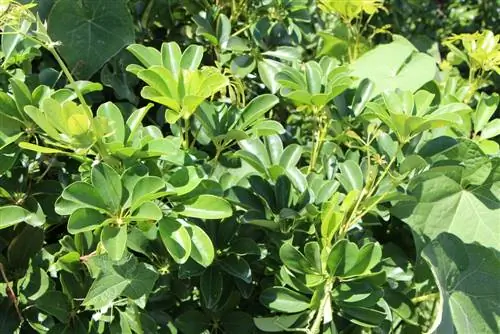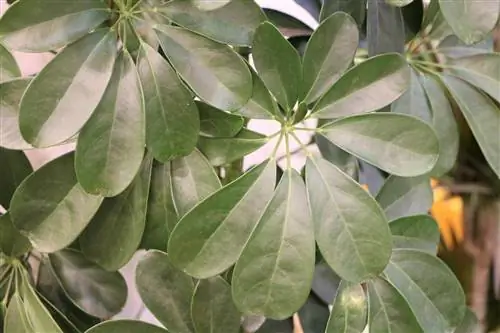- Author admin [email protected].
- Public 2023-12-17 03:39.
- Last modified 2025-01-24 12:45.
Schefflera arboricola originally comes from tropical climates and has gained great popularity as an office plant in the past. The unusual plant has now been forgotten, although some attributes are particularly interesting for both beginners and advanced users. The Schefflera is easy to care for and robust. It is easy to propagate, is an eye-catcher and cleans the air of nicotine and acetone.
Profile
- evergreen shrub
- belongs to the Aralia family
- original homeland is in Taiwan and on the island of Hainan
- reaches heights of up to four meters
- Flowers hermaphrodite, inconspicuously colored green-yellow
- Flowering period between July and October
- blooms in Central Europe only under tropical conditions
- colorful varieties: 'Renate', 'Charlotte', 'Samoa Snow' and 'Melanie'
Location
As a tropical plant, Schefflera arboricola has special requirements when it comes to lighting, temperature and wind conditions. It normally grows in the protection of tall jungle giants and knows how to make optimal use of the diffuse remaining light. Therefore, the plant should not be placed on the south window in the apartment. Avoid direct sunlight as the leaves burn very easily. Choose a spot with less light near a window. A location near the heating is not a problem for the Schefflera. On the other hand, she doesn't like drafts or places that are too shady. The plant likes to spend the summer in a bright and wind-protected place on the terrace or balcony. If you pay attention to these needs, your radiant aralia will grow splendidly:
- tolerates three to five hours of sunshine in the morning or evening
- requires minimum temperatures of 15 °C during the day
- at night the thermometer can drop to twelve degrees
- Temperatures below ten degrees damage the plant
Note:
Light-leaved Scheffleras cope with sunlight better than dark-leaved varieties.
Substrate
Schefflera arboricola thrives in any standard soil. To support particularly magnificent and he althy growth, you should avoid using simple potting soil from hardware stores and garden centers. The substrates often do not meet the requirements for water and nutrient regulation as well as buffering power. In addition, the pH value is crucial for vitality. A value of around 6.0 is ideal. If you mix a high-quality substrate, you will get a loose soil that does not compact:
- four parts humus substrate
- two to three parts clay
- half a part of quartz sand
- a part of pumice gravel, lava granulate or lavalite
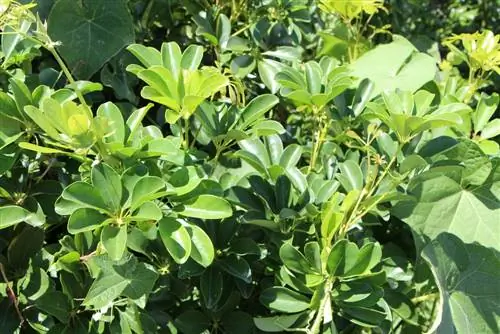
By adding clay you can regulate the pH value. This should be sterilized before use. The decisive factor for the pH value is the mixing ratio of humus substrate to clay. Check the pH value for the respective substrate on the packaging. For this mixture the value is between 6.0 and 6.5.
Hydroculture
The Schefflera is one of the standard plants that are grown hydroponically. The tropical plants do not grow in potting soil, but in clay granules or expanded clay. This alternative substrate offers support and stability to the plants. It soaks up water and ensures an optimal water supply. A nutrient solution provides the houseplants with permanent nutrients. With this variant you benefit from several advantages:
- Plants need to be watered less often
- limited root formation
- repot and cut back less often
Pouring
Radiated aralia have a medium water requirement and enjoy moderately moist soil. Keep the substrate constantly moist in summer. During the winter months, the soil may dry on the surface between watering sessions. The amount of water depends on the size of the pots, ambient temperature and light exposure. The larger the pot, the more water the soil can absorb without becoming waterlogged. If your Schefflera arboricola gets sun or is in heated rooms, it needs a little more water than in partially shaded and cool places. You can use these values as a guide:
- water once a week in summer
- water every ten days in winter
- occasionally splash with water
Fertilize
Newly purchased plants are supplied with nutrients that will be used up within the next six to eight weeks. You should then fertilize the Schefflera every seven to 14 days. Use a complete fertilizer dosed according to the manufacturer's instructions. When the main growth phase comes to an end, fertilization is slowly reduced and eventually stopped. If you overwinter your radiant aralia in a warm place, offer it additional nutrients every four weeks.
Note:
If you cultivate the radiant aralia hydroponically, you should regularly supply it with a special fertilizer. Conventional plant fertilizers are too concentrated.
Cutting
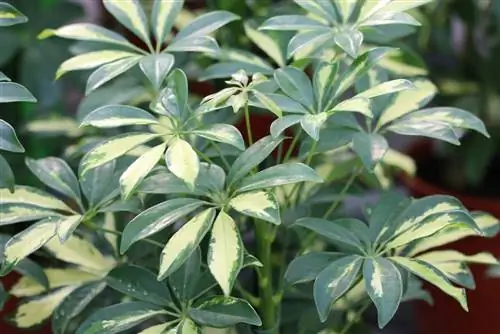
The best time for pruning is early spring, before the new growth phase begins. You should shorten shoots that are too long every year so that the plant gets more light inside. This stimulates the formation of fresh shoots and the plant grows dense and bushy. The fast-growing radiant aralia maintains a compact shape and branches better. Since the woody plants are extremely robust, even radical pruning does not cause them any problems. Always cut branches just above a bud or directly at the branch fork and proceed as follows:
- Trim shoot tips
- Cut back runners
- Short side and main shoots
Propagate
Schefflera arboricola is usually propagated by cuttings. The shoot pieces should be about ten centimeters long and have two leaves. Cut off non-woody shoots just above a node and then cut the cutting below the next node. To reduce evaporation, you can cut the leaves in half or roll them up and secure them with a rubber band. If you take the following tips into account, the cutting will often form its first roots after a month:
- Growing in a water glass or planter
- no direct sunlight
- Temperature between 18 and 24 °C
Planting
As soon as the cuttings have formed sufficient roots, they are placed in a planter filled with substrate. The original forest plant is cultivated as a houseplant in Central Europe because its demands mean it cannot survive outdoors. Do not choose a pot that is too large, otherwise the plant will tend to overgrow. The pot volume should be about 20 percent larger than the volume of the root ball.
Repotting
Repotting is necessary when the plant has completely rooted through the substrate. To prevent a lack of space and stunted growth, you should place young Scheffleras in a new planter every spring. Older plants can be transplanted every three to five years. After you have removed the plant from the old pot, the roots are freed from substrate and untangled. Cut back dead and rotten roots. The further procedure is not difficult:
- equip new planter with drainage
- fill a third with substrate
- Insert root ball
- fill with humus-rich substrate and press down
- don’t forget to water
Tip:
Instead of repotting the plant every year, you can alternatively remove and replace the top layer of soil. This means the Schefflera gets fresh soil and doesn't grow over your head.
Wintering
In its natural habitat, the Schefflera does not take a break. However, their growth stagnates in Central Europe as both light intensity and temperatures decrease in winter. The leaves remain intact in winter and require sufficient light. If it is too dark in your apartment, you can use energy-saving plant lamps. Additional lighting is not necessary if the plant is in the winter garden or in front of large south-facing windows. The thermometer should not fall below 15 degrees Celsius between October and March. Variegated varieties require a temperature of at least 18 degrees Celsius. Care is limited and only increased again with the new shoots in spring.
Pests
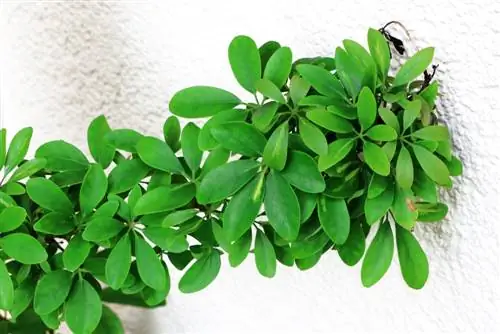
Although the radiant aralia proves to be robust against dry heating air, pest infestation can still occur during the winter months. Check the plants regularly for spider mites and mealy bugs. The unwanted insects don't stop at almost any houseplant and should be removed with a strong jet of water. Garlic cloves, lavender plants and cloves have been shown to be good preventive agents. If you cultivate the plants in the winter garden, you should also pay attention to aphids.
Growth disorders
If the houseplant develops brown and yellow leaves during the growth phase and then fall off after a short time, the location should be covered. Cold or drafts, as well as a lack of sunlight, can cause leaves to fall. Move your plant to a warmer location near a window and watch it continue to grow. Hobby gardeners often suspect that leaf fall results from a lack of water. However, increased watering does not combat the problem, but rather promotes waterlogging. This can lead to root rot.

